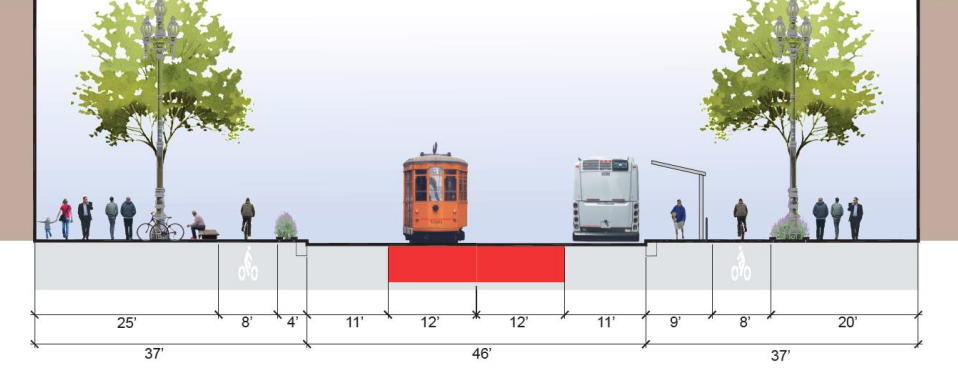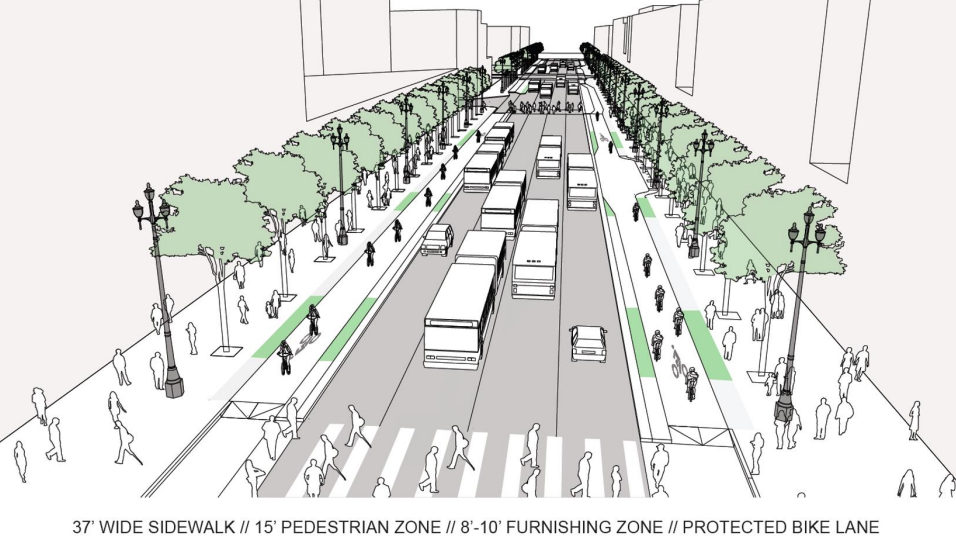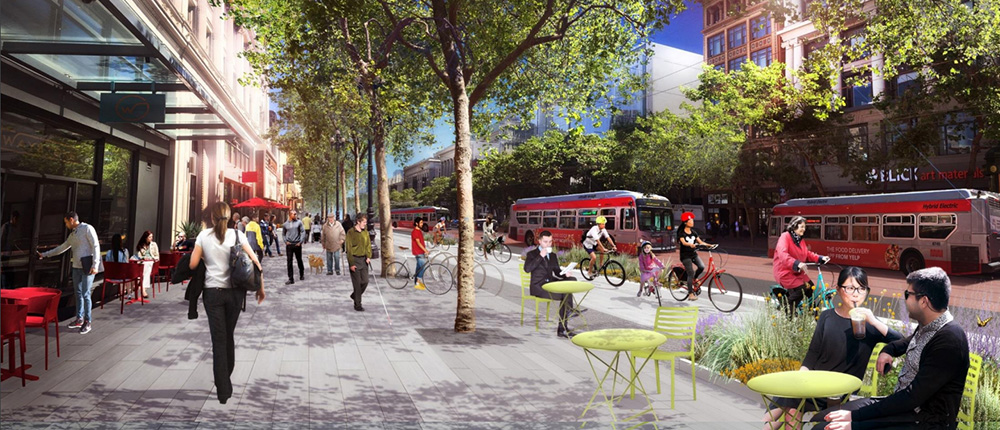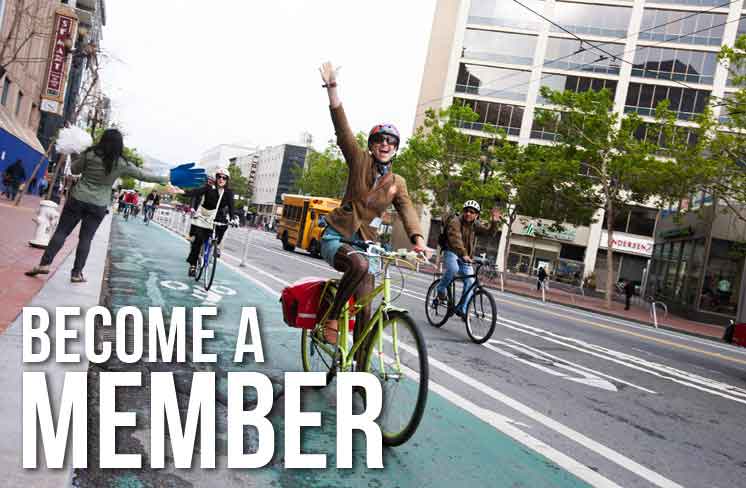Editors: This story was originally published in Issue 161 of our quarterly Tube Times magazine, one of many perks of membership in the San Francisco Bicycle Coalition. This piece has been edited to include corrections from historian LisaRuth Elliott, co-director of Shaping San Francisco and FoundSF.org.
The spine of San Francisco, Market Street is our city’s defining boulevard, cutting diagonally and gluing together our downtown — the street that was an imagined boulevard even before our city was named for Saint Francis.
A TURBULENT GENESIS
In 1843, a 26-year-old surveyor mapped out Market Street, a wide street so vast that there was a “protest against the plan as [showing] wanton disregard for rights of landowners,” historian Thomas Prendergast wrote. And so the young Jasper O’Farrell fled an incensed mob by horse and boat, hiding out in Sonoma County until he felt safe returning to San Francisco. But his plans for an expansive, central boulevard set the course for the Market Street we know today.
It had to wait until 1860 — when a series of 80-foot sand dunes from Second to Fourth streets were finally leveled— to become more than a line on a map. Soon thereafter, Market Street established its place as the centerpiece of our city, however. Bicycles were early fixtures there; the nationwide “Good Roads” movement came at the peak of bicycle use, as people biking demanded better, more bikeable streets. On July 25, 1896, San Francisco bike advocacy was on full display with people on bikes parading down Market Street and beyond. Witnessed by over 100,000 spectators, advocates purposefully walked their bicycles down stretches of Market to demonstrate the disrepair of the street. The next day, one newspaper headline read, “San Francisco Bicycle Riders—Disciples Of Progress,” and Market Street was paved two years later.
After the devastating 1906 earthquake ravaged San Francisco, Market Street solidified its place in our cityscape as the iconic “Path of Gold” with new lights from the Ferry Building to the Castro. Collectively designated as San Francisco Landmark no. 200, these ornamental lampposts lining Market Street were first designed in 1908 by Willis Polk, an architect famous for his local works from the Palace of Fine Arts to the restoration of Mission Dolores. In 1916, the decorative tops were designed to fill out the full 33-foot-tall features and were installed throughout the following decade, capping the street lights as we know them today.
LAWRENCE HALPRIN’S DANCE
Planning for what would become the Bay Area Rapid Transit (BART) system began in the late 1940s. This new subway system would need to move huge numbers of passengers and shuttle them from city to city, even crossing the bay. When the final plan was completed in 1961 and sent through the bevy of necessary approvals, there was no surprise that BART would traverse San Francisco beneath the grand boulevard of
Market Street. The impending construction of BART and Muni Metro light rail led planners to ask a very simple question: “What to do about Market Street?”
This was the title of a SPUR-sponsored report published in 1962, and thus entered renowned landscape architect Lawrence Halprin, selected to develop plans for a full redesign of Market Street. Inspired by his partner Anna, a distinguished choreographer, Halprin’s vision began with the experience of people walking this boulevard in motion.
“All of Halprin’s designs reflect this passion to give people as many options as possible to go this way or that, to reverse directions, to pause, to start over, to be alone, to meet others, and to experience as many different sights, smells and sounds as the site permits,” wrote Benjamin Forgey in the December 1988 issue of The Smithsonian. As remarked by the famous urbanist Jane Jacobs, “A promenade needs promenaders.” Halprin’s layout dreamt of this urban ballet with wide brick sidewalks, open plazas and street furniture for Market Street, lending it a character distinct from all other San Francisco streets.
In the decades since, we’ve come a long way from O’Farrell’s controversially wide design to Halprin’s elegant dance of urban life. Key features of Halprin’s design never quite materialized into the beautiful portrait he painted, however. For example, the controversial fountain at Justin Herman Plaza once complemented the double-decker Embarcadero Freeway. This brutalist design looks like a harsh playground of concrete blocks out of place on today’s waterfront, however. Other open spaces that Halprin designed for people to linger, rest and socialize, like UN Plaza at Civic Center and Hallidie Plaza near Powell Street, fall short of their envisioned purposes.
Instead, today’s Market Street feels more narrow than ever, cramped and pinched, with every movement confined and chaotic. There is no time to breathe and appreciate our city. Biking is reserved for those who are confident riding between Muni buses and streetcars while competing with cars and delivery trucks for space. Each stop-and-go at a traffic light is a race, as people biking jockey for position to navigate the perils of today’s Market Street as quickly as possible.

Cross-section of new Market Street proposal gives an example of the detail needed for every unique segment of our city’s grand boulevard. Image courtesy of the SF Public Works.
ENTER “BETTER MARKET STREET”
A long-languishing dream approaching 10 years of planning, the City’s Better Market Street project is finally back in public view. With a robust project team to coordinate the various agencies, City leadership has made it clear that San Franciscans cannot wait any longer to overhaul and redefine Market Street. The first segment of the full 2.2- mile length from the Embarcadero to Octavia is on track to begin construction by the end of 2018.
Starting from Halprin’s original vision of a people-first place, a new design proposal emerged in July 2017, capturing our collective imaginations. The new plans finally dedicate space exclusively to people biking, with fully separated bike lanes elevated to sidewalk level. Biking will no longer be a competition as everyone slows down and has time to appreciate our urban landscape. Transit will be prioritized, with boarding islands reconfigured and buses and streetcars picking up passengers and delivering them to their destinations more frequently and quickly thanks to transit-only lanes.
The proposal discourages any who might be tempted to drive private autos down Market, with turn restrictions improving the flow across, connecting SoMa to northern neighborhoods more seamlessly. Businesses will thrive with the increased foot traffic, with curbside loading zones for deliveries helping ensure that merchants can meet increased demand. Proposed passenger drop-off zones will accommodate
the unique needs of hotels and other popular destinations.
With the new bike lanes and boarding islands, the curb will extend to nearly 40 feet from buildings in some locations, creating more space than ever for people. To define where people will bike, the City proposes a wide variety of options to physically separate the bike lane from the sidewalk. This is where the public’s creativity is needed to shape the sort of landscaping, art and urban comforts that will help create welcoming places for people on Market Street. Seeking both form and function, we know that we need space for current fixtures, like bike racks, signage and newsstands. But we also want more resting places to accommodate people enjoying their coffee or meeting with friends while still enjoying the feel of the street. And we envision new aesthetics that serve everyday pedestrians, creating the uniqueness we have always sought for Market Street while preserving the historic Path of Gold — a promenade that celebrates and invites promenaders.

Early conceptual prototype inspiring the latest plans for the future of Market Street. Image courtesy of the SF Public Works.
The new design for Better Market Street is emerging, but the details are far from complete; everything as described is still an early proposal. While the City’s project team has developed a sketch, they seek input from the public on the details to fill out the drawing.
Your San Francisco Bicycle Coalition is committed to continuing our calls for protected bike lanes from the Embarcadero all the way through Octavia. This is our chance to make good on that promise, and we know that there is still so much work to be done to add this new chapter to Market Street’s story.
Over the next year, we will encourage members to share your experiences of biking on Market Street and how proposed project designs would impact you. We know that this project is not just for people who bike there today, though. As the spine of our city, a truly bike-friendly Market Street means that everyone feels comfortable biking there, especially the people who fear biking given today’s conditions. Welcoming those people to the fun and freedom of biking in San Francisco remains a top priority.
So we have one ask: Tell people about this project. Share the history with them and come up with what you think the next generation’s Market Street should look like. Do not be shy about Market Street because we won’t be. We have a dream to realize.
The Tube Times is published quarterly as one of the many benefits to members of the SF Bicycle Coalition. For a complete list of membership benefits, or to join/renew today, click here.


